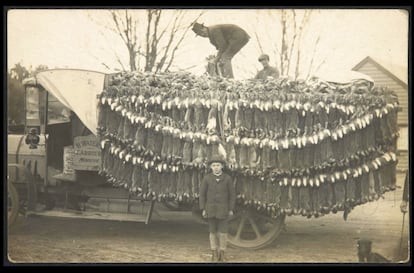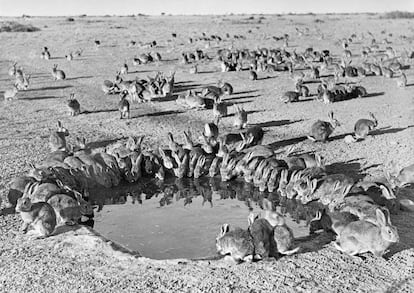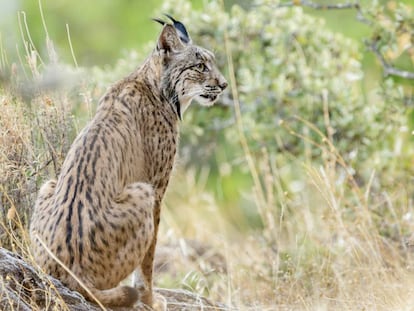‘It was a perfect storm’: How 13 rabbits caused the largest biological invasion in history
Genetics confirms that a single shipment of these animals, some domestic and some wild, led to their explosive expansion in Australia

On Christmas Eve, 1859, 24 rabbits arrived at Thomas Austin’s hunting estate near Sydney in eastern Australia. Just two months earlier, his brother William Austin had sent him 13 rabbits from southern England. Three years later, the local press reported that there were already thousands of European leporids in the country. Thomas himself acknowledged that he had slaughtered 20,000 of the animals on his property. By 1906, the rabbits had reached Australia’s west coast, 4,000 kilometers (about 2,485 miles) away from Thomas Austin’s property. Now, a genetic study confirms that the Austin brothers’ rabbits started the largest biological invasion ever recorded.
The contemporary press and history books note the Austins’ culpability in the disaster. Even William’s granddaughter, Joan Palmer, tells her version of the story in her memoirs. But many scientists and historians acknowledge that it’s more complicated than that: the English settled in Australia in 1788, when the ships of the First Fleet arrived on a mission for the British crown to turn the huge island into a penal colony. Five rabbits were aboard one of the ships that made the voyage. Records show that there were another 90 shipments of rabbits over the next 70 years. Some of the animals escaped or were released deliberately, but none of them caused a biological invasion. The proliferation of wild rabbits has damaged Australian ecosystems and cornered marsupials; rabbits are the continent’s main agricultural pests. For over a century and a half, Australians have tried everything to stop the invasion, from rifles and fences, to ferrets and phosphorus poisons, to viruses and bacteria. So, what happened on Christmas Eve in 1859?
A group of British, Portuguese and Australian researchers have used genetics to confirm the Austin brothers’ responsibility for the disaster. The scientists analyzed the genes of almost 200 rabbits from Spain (the common rabbit’s place of origin), France (where the animals were domesticated during the Middle Ages), England, Australia and two other countries that also suffered the scourge: neighboring New Zealand and Tasmania. Several specimens come from a few years after the invasion began. This data allowed the scientists to create a genetic tree to study how the rabbits’ proliferation occurred. The researchers published their findings in the scientific journal PNAS (Proceedings of the National Academy of Sciences of the United States of America).
“Their wild ancestry probably gave these rabbits an advantage, as they were better adapted to the harsh Australian landscape”Joel Alves, researcher at the University of Oxford and the Research Center for Biodiversity and Genetic Resources, Portugal
Joel Alves, a researcher at the University of Oxford and the Research Center for Biodiversity and Genetic Resources in Portugal, and the study’s lead author, explains what they hoped to find by recreating the rabbit gene tree: “We looked for a combination of different genetic markers that we expect when populations expand.” Importantly, they saw that almost all Australian rabbits are closely related, despite being separated by thousands of kilometers. “Something like that would not have been possible if there had been other successful introductions,” notes Alves. He adds that “the further away the rabbit populations are from Victoria [the state where the invasion originated], the less genetic diversity they have. This is to be expected from a large significant expansion from a single place, because genetic diversity erodes as individuals expand rapidly.” Biologists call this the founder effect.
Analysis of mitochondrial DNA, which is inherited exclusively through the maternal line, has allowed the researchers to estimate the number of females behind the proliferation of hundreds of millions of Australian rabbits: William sent only five females to Thomas. Genetics has also helped the scientists confirm the rabbits’ geographical origin. On the European branches of the genetic tree, the Australian rabbits are closest to the ones connected to the United Kingdom’s southwest, where William Austin’s land was located. But what was so special about the Austin rabbits as compared to the ones that arrived in Australia earlier?

“The right rabbits were in the right place at the right time”
“We have historical and genetic evidence that most of the previous introductions were domestic rabbits. Austin’s are the only ones explicitly described as wild and captured in a natural environment, which we have confirmed genetically,” says Alves. One piece of historical proof is the memoir of Joan Palmer, William Austin’s granddaughter. She recalls that Thomas asked William to send him a dozen wild rabbits to release on his hunting grounds. The emigrant belonged to one of the acclimatization societies that sprang up in the 19th century. These associations imported species from their homelands to introduce them into the colonies, out of both longing and economic interests. But that had dire consequences in the many ecosystems exposed simultaneously to the actions of white settlers and invasive species. In the Austins’ case, William captured only six wild rabbits and bought another seven from neighbors who had trapped the animals as young and then domesticated them. The rabbits had to interbreed during the journey to match the 24 animals that appear in the historical records.
Alves explains “their wild ancestry probably gave these rabbits an advantage, because they were better adapted to the harsh Australian landscape.” In addition to their gray to brownish coloration, which is ideal for camouflage in the dry, semi-arid terrain, the wild rabbits retained their flight response to danger. Domestic rabbits are an easier target for predators because they have lost that reaction and are more docile and more strikingly colored.
“In Australia rabbits have evolved with changes in body shape to help regulate their temperature”Francis Jiggins, a professor of genetics at the University of Cambridge.
Francis Jiggins, a professor of genetics at the University of Cambridge and a senior author of the study, notes that “there are numerous traits that could make domestic rabbits of wild origin poorly adapted for survival in the wild, but it is possible that they lacked the genetic variation needed to adapt to Australia’s arid and semi-arid climate.” He concludes that “to cope with this [environment], Thomas Austin’s wild rabbits and their offspring had a genetic advantage in adapting to these conditions.”
Martín Nuñez, a researcher at the University of Houston and an expert in invasion ecology, says that the investigation’s results are compelling, although they are at odds with previous research that finds rabbits spread throughout Australia from different places at different times. “[Determining] why some species invade and others don’t is invasion biology’s holy grail. We’ve been trying to find that out for decades. This study didn’t find the holy grail, but it provides information about the processes through which it can happen,” he explains. Nuñez notes that the research “shows that it’s not so much about the species, but about a population of potentially pre-adapted individuals.” This work also demonstrates that the view of rabbits as a highly invasive species, at least outside of Europe, is wrong, “since here it is very clear that a given population at a specific time was responsible [for the biological invasion], while other populations had much more limited success.”
Alves acknowledges that genetics are not the only explanation for the invasion: “It is likely that changes in the environment also played a role when the Austin rabbits arrived. Australia in 1788 was very different from Australia in 1859; by the mid-19th century, the country had extensive grazing land that could feed rabbits, and herders killed fewer predators. So, it was the perfect storm; the right rabbits were in the right place at the right time.”
Tu suscripción se está usando en otro dispositivo
¿Quieres añadir otro usuario a tu suscripción?
Si continúas leyendo en este dispositivo, no se podrá leer en el otro.
FlechaTu suscripción se está usando en otro dispositivo y solo puedes acceder a EL PAÍS desde un dispositivo a la vez.
Si quieres compartir tu cuenta, cambia tu suscripción a la modalidad Premium, así podrás añadir otro usuario. Cada uno accederá con su propia cuenta de email, lo que os permitirá personalizar vuestra experiencia en EL PAÍS.
¿Tienes una suscripción de empresa? Accede aquí para contratar más cuentas.
En el caso de no saber quién está usando tu cuenta, te recomendamos cambiar tu contraseña aquí.
Si decides continuar compartiendo tu cuenta, este mensaje se mostrará en tu dispositivo y en el de la otra persona que está usando tu cuenta de forma indefinida, afectando a tu experiencia de lectura. Puedes consultar aquí los términos y condiciones de la suscripción digital.
More information
Últimas noticias
Mexico’s missing people crisis casts a shadow over World Cup venue
Can cheese protect brain health? This is what the science says
The life of a delivery driver in China: ‘Many people don’t know how an order can arrive at their home in just one day’
Maude Apatow, from acting in ‘Euphoria’ to directing: ‘There are many films that you can tell weren’t written by someone young’
Most viewed
- Christian Louboutin: ‘Young people don’t want to be like their parents. And if their parents wear sneakers, they’re going to look for something else’
- US sanctions against jailed cartel leader ‘El Marro’ highlight Mexico’s lack of control over its prisons
- Cartels in Mexico take a leap forward with narco-drones: ‘It is criminal groups that are leading the innovation race’
- Liset Menéndez de la Prida, neuroscientist: ‘It’s not normal to constantly seek pleasure; it’s important to be bored, to be calm’
- ‘El Limones’ and the growing union disguise of Mexican organized crime











































